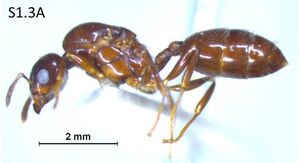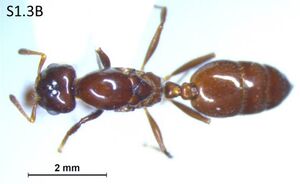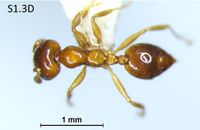Crematogaster hullettii
| Crematogaster hullettii | |
|---|---|

| |
| Scientific classification | |
| Kingdom: | Animalia |
| Phylum: | Arthropoda |
| Class: | Insecta |
| Order: | Hymenoptera |
| Family: | Formicidae |
| Subfamily: | Myrmicinae |
| Tribe: | Crematogastrini |
| Genus: | Crematogaster |
| Species group: | decamera |
| Species subgroup: | decamera |
| Species: | C. hullettii |
| Binomial name | |
| Crematogaster hullettii Feldhaar, Maschwitz & Fiala, 2016 | |
A member of a group of Crematogaster species associated with Macaranga plants in Sumatra, Borneo, and Peninsula Malaysia.
Identification
Feldhaar et al. (2016) - A member of the Crematogaster decamera subgroup within the Crematogaster borneensis group. Worker: Propodeal spines present, scape index (SI) < 0.65, head as wide as long (CI ~ 1.0), legs relatively short, RLEG 0.58 to 0.62. Queen: EL 0.39 – 0.47 mm (rarely > 0.45), REL 0.32-0.4, OD1 > OW, ROD between 0.09 - 0.13.
Keys including this Species
Distribution
Latitudinal Distribution Pattern
Latitudinal Range: 4.2022° to 4.2022°.
| North Temperate |
North Subtropical |
Tropical | South Subtropical |
South Temperate |
- Source: AntMaps
Distribution based on Regional Taxon Lists
Indo-Australian Region: Borneo, Malaysia (type locality).
Distribution based on AntMaps
Distribution based on AntWeb specimens
Check data from AntWeb
Countries Occupied
| Number of countries occupied by this species based on AntWiki Regional Taxon Lists. In general, fewer countries occupied indicates a narrower range, while more countries indicates a more widespread species. |

|
Estimated Abundance
| Relative abundance based on number of AntMaps records per species (this species within the purple bar). Fewer records (to the left) indicates a less abundant/encountered species while more records (to the right) indicates more abundant/encountered species. |

|
Biology
Feldhaar et al. (2016) - Crematogaster hullettii occurs on Peninsula Malaysia and in Sarawak. On Peninsula Malaysia the species seems to be restricted to higher elevation sites, e.g. Genting Highlands or Fraser’s Hill above approximately 500m where it mainly inhabits Macaranga hullettii as well as Macaranga bancana, which ceases to occur with increasing elevation. In Sarawak (Borneo) it was mainly found in lowland sites (but higher elevational regions were little sampled there). Queens on Borneo also colonize only seedlings of non-waxy host species of the section Pachystemon (Macaranga angulata, M. bancana, M. hullettii, Macaranga petanostyla, Macaranga umbrosa).
Castes
Queen
 
| |
| . | |
Nomenclature
The following information is derived from Barry Bolton's Online Catalogue of the Ants of the World.
- hullettii. Crematogaster hullettii Feldhaar, et al. 2016: 662, fig. S1.3A-D (w.q.) WEST MALAYSIA.
- Type-material: holotype queen, 1 paratype worker.
- Type-locality: holotype Malaysia: Genting Highlands (Bunga Buah), 6.vii.1999, from Macaranga hulletti (H. Feldhaar); paratype with same data.
- Type-depository: SMNK.
- Distribution: Malaysia (Peninsula, Sarawak).
Unless otherwise noted the text for the remainder of this section is reported from the publication that includes the original description.
In Quek et al. (2007) the lineages from the two regions are sister groups, i.e. monophyletic but with some genetic differentiation. Two samples contained in the phylogeny based on mitochondrial DNA and collected in eastern Sarawak cluster with samples of Crematogaster claudiae from Sabah and thus surprisingly with the Crematogaster captiosa-subgroup (Feldhaar et al., 2010). However, based on morphological measurements these samples clearly fall within Crematogaster hullettii. As hybridization events or introgression of mitochondrial DNA seem to occur in this species complex (2.5% hybrid individuals were found among two species of the C. captiosa-subgroup in one area; Feldhaar et al. 2008), we place a stronger emphasis on the morphological data.
Description
Worker
Paratype. CI 1.0, DPPW 0.18, DPW 0.19, EL 0.11, HL 0.65, HW 0.65, LHT 0.43, LPS 0.082, MTW 0.39, PI 1.04, REL 0.17, RLEG 0.59, SI 0.59, SL 0.39, (TL 2.5), WL 0.73.
CI 0.96-1.03, DPPW 0.16-0.21, DPW 0.17-0.21, EL 0.11-0.13, HL 0.57-0.7, HW 0.58-0.69, LHT 0.39-0.47, LPS 0.062-0.09, MTW 0.34-0.41, PI 1.0-1.15, REL 0.17-0.19, RLEG 0.58-0.62, SI 0.57-0.62, SL 0.35-0.4, (TL 2.4-3.0), WL 0.66-0.80.
Colour medium to dark brown with head and gaster being a slightly darker shade than the alitrunk. Workers monomorphic in size. Total body length of workers 2.4 mm to 3.0 mm. Head, alitrunk and gaster shiny with smooth surface, only mesonotum slightly less shiny. All body parts bear appressed pubescent hairs. Long flexuous setae present on head, gaster and abdomen: on head only few in frons, on gaster more on the posterior margins of tergites and sternites. Only few setae on alitrunk and one pair each on petiole and postpetiole. Head subquadratic and approximately as wide as long (CI 0.96-1.03) usually being only slightly rounded on sides. Anterior clypeal margin slightly convex and with a row of long erect setae projecting anteriorly. Occipital margin slightly concave, occipital lobes rounded. Mandibles relatively short and with four denticles, capable of closing tightly against the clypeus. Denticles increasing continuously in size from most proximate to most distal denticle. Surface of mandibles smooth, covered with short pubescent hairs. Antennae relatively short in comparison to head width (SI 0.57-0.62; mean SI: 0.6) and covered in short pubescent hair. Segments of the funiculus continuously increasing in size, with the terminal three funicular segments forming a club.
Compound eyes elliptically-shaped and not protruding over margin of head in full-face view. Pronotum and mesonotum form a convex dome in profile. Anterodorsal surface of pronotum sloping downwards less steep than posterodorsal surface of mesonotum. Metanotal groove slightly notched and clearly developed, whereas the promesonotal suture is visible but not prominent.
Propodeal spines are present but short. The tip of the spine protrudes only slightly over the posterior margin of the propodeal spiracle (Fig S1.3C and S1.3D). Slope of the posterior face of the propodeum similar to posterior slope of mesonotum and approximately 45°. Legs relatively short in comparison to alitrunk length (RLEG: 0.58-0.62). Node of petiole and postpetiole in dorsal view rounded. Petiole only slightly longer and always as wide as or wider than postpetiole (PI 1.0-1.15). Subpetiolar process usually absent.
Queen
Holotype. CI 1.01, DPPW 0.45, DPW 0.43, EL 0.42, HL 1.28, HW 1.29, LHT 0.95, MTW 1.13, OD1 0.15, OD2 0.06, OW 0.13, PI 0.95, REL 0.33, RLEG 0.41, ROD 0.12, ROD2 0.049, SI 0.51, SL 0.66, (TL 6.5), WL 2.35.
CI 0.96-1.07, DPPW 0.41-0.48, DPW 0.39-0.47, EL 0.39-0.47, HL 1.18-1.29, HW 1.15-1.29, LHT 0.84-1.04, MTW 0.88-1.23, OD1 0.12-0.17, OD2 0.06-0.09, OW 0.11- 0.13, PI 0.95-1.03, REL 0.32-0.4, RLEG 0.39-0.46, ROD 0.09-0.13, ROD2 0.049-0.08, SI 0.51-0.55, SL 0.63-0.68, (TL 6.2-7.0), WL 1.92-2.36.
Queens relatively small with total body length 6.2 to 7.0 mm and uniformly dark brown in colour. Surface of head and gaster smooth and shiny, alitrunk slightly less shiny and faintly shagreened. All body parts bear appressed pubescent hairs. Long, flexuous setae present on head gaster and abdomen: on head especially in frons, on gaster more on the posterior margins of tergites and sternites. A row of long erect setae pointing anterior are present on the clypeus. Mandibles relatively short, capable of closing tightly against the clypeus.
Head usually approximately as wide as or wider than long (CI: 0.96-1.07; mean 1.01). Head wider behind the compound eyes than anterior closer to the clypeus. Sides of the head straight, occipital margin of the head slightly concave. Occipital lobes rounded. Anterior clypeal margin slightly convex. Terminal four segments of funiculus continuously increasing in size forming an antennal club. Antennal scrobes strongly developed, with an acute and marked dorsal margin; the frontal carinae short.
Compound eyes small (0.39-0.47 mm) and usually span approximately one third of HL (REL 0.32-0.4). Compound eyes oval in shape from lateral view and convex from dorsal view with margins of compound eyes protruding over margin of head. Ocelli relatively small in diameter. Diameter of the median ocellus smaller than the distance between the lateral ocelli.
Mesoscutum convexly rounded anterodorsally. Mesoscutellum nearly in horizontal plane in lateral view. Propodeum flattened dorsally and then drops off at an angle of approximately 45° posterior of the propodeal spiracle. Mesoscutum stretches out over less than half of the alitrunk in lateral view. In dorsal view, the posterior margin of the propodeum forms a straight line and the mesonotum is broadly triangular. Propodeum not armed with spines.
Petiole in dorsal view broadly rounded on sides and approximately as wide as postpetiole (PI: 0.95-1.03). In lateral view the petiole anterodorsally flattened and sloping downwards and slightly longer than the postpetiole. Postpetiole round in dorsal view.
Type Material
Holotype. Queen (to be deposited in Staatliches Museum für Naturkunde Karlsruhe, provisional specimen number HF99-Mhull1-Q) (H. Feldhaar) on 6.7.1999 in Genting Highlands (Bunga Buah) from Macaranga hullettii (deposited in SMNK). Paratype. Worker collected from the same colony (to be deposited in SMNK, provisional specimen number HF99-Mhull1-W).
Determination Clarifications
In former publications by our group this species was referred to as Crematogaster msp. 3 (Fiala et al., 1999; Feldhaar et al., 2003a; Feldhaar et al., 2010).
